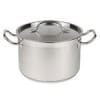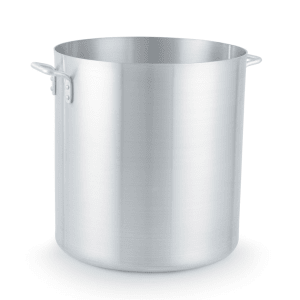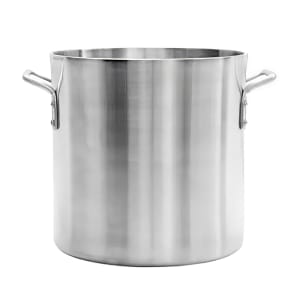Stock Pots
Ideal for cooking stocks and soups, as well as many other foods, stock pots are a necessity in any commercial kitchen. More

The most economical stock pot options are made of aluminum. These are available in many sizes ranging from 8 to 120 quarts.

Durable and corrosion-resistant stainless steel pots are available in a wide range of sizes, with many models being induction-ready.
Large Stock Pots: What You Need to Know
A stock pot is an essential piece of cookware designed to heat rapidly and simmer evenly. Typically, they're quite large and come equipped with or without a lid. Most stock pots are fitted with handles for swift transport. Stock pots are extremely versatile and can be used to simmer soups and stocks, boil pasta, and even steam and blanch vegetables.
Common Questions About Stock Pots
What materials are stock pots constructed of?
Stock pots can be constructed of stainless steel, aluminum, or a tri-ply material. Stainless steel is very durable and can withstand heavy use, so stainless steel stock pots are easy to clean while resisting dents and warping. Stainless steel has a low reactivity that prevents it from transferring flavors and enables it to withstand acidic foods, such as tomato sauce. Aluminum stock pots heat quickly and transfer heat evenly. They're designed for back burner use, as they can boil water, braise meats, and reduce stocks effectively. Tri-ply stock pots consist of an aluminum core between stainless steel. The aluminum in tri-ply stock pots heats quickly while the steel retains heat and provides durability.
Do you need riveted or welded handles?
Most stock pots are equipped with handles – one on each side of the pot – that enable users to lift and transport them. Stock pots are equipped with either riveted or welded handles. Riveted handles feature rivets – small bits of metal that work as permanent fasteners – that attach the handles to the stock pot. Welded handles are welded, or melted, onto the stock pot, forming a permanent attachment. The major difference between riveted and welded handles is the ease of cleaning. Because welded handles are melted to the stock pot, there are no creases to capture particulate. Debris can get trapped in rivets, which makes them more difficult to clean than welded handles.
How much can a stock pot hold?
Stock pots are often the largest piece of cookware in a commercial kitchen. The smallest stock pot can hold 3.38 quarts, while the largest can hold 160 quarts. Ideal for schools, hospitals, and prisons, large stock pots can be used to cook large batches of stocks, soups, pastas, and anything else that fits. A medium to small stock pot is better suited for regular restaurants and smaller establishments, as those kitchens may not have the room to accommodate large stock pots.
What special features are available?
Stock pots can come with various features to improve operation. Some stock pots include a faucet fitted to the bottom of the pot. This faucet enables the user to drain liquid without lifting the pot, eliminating strain on employees. Some stock pots come with lids and covers to lock in heat and prevent debris from falling in. Induction-ready stock pots are designed for compatibility with induction cooktops.


